Analysis of Motivating People in Organisations: Behaviour & Management
VerifiedAdded on 2023/06/10
|8
|1982
|493
Report
AI Summary
This report analyzes the motivation of people within organizations, drawing insights from articles by Lazaroiu, Udrescu, and Gheorghe. It explores how employee motivation enhances performance and satisfaction, highlighting the role of managers in fostering a motivated workforce. The analysis covers motivational determinants, the link between job performance and need satisfaction, and the impact of motivation on organizational behavior. Key findings emphasize the importance of recognition, empowerment, and effective leadership in driving employee motivation and improving organizational performance. The report also touches on the relationship between employee motivation and customer satisfaction, suggesting areas for further research. Access this comprehensive analysis and more on Desklib, your platform for academic success.

Organisational Behaviour & Management
6 / 2 9 / 2 0 1 8
6 / 2 9 / 2 0 1 8
Paraphrase This Document
Need a fresh take? Get an instant paraphrase of this document with our AI Paraphraser
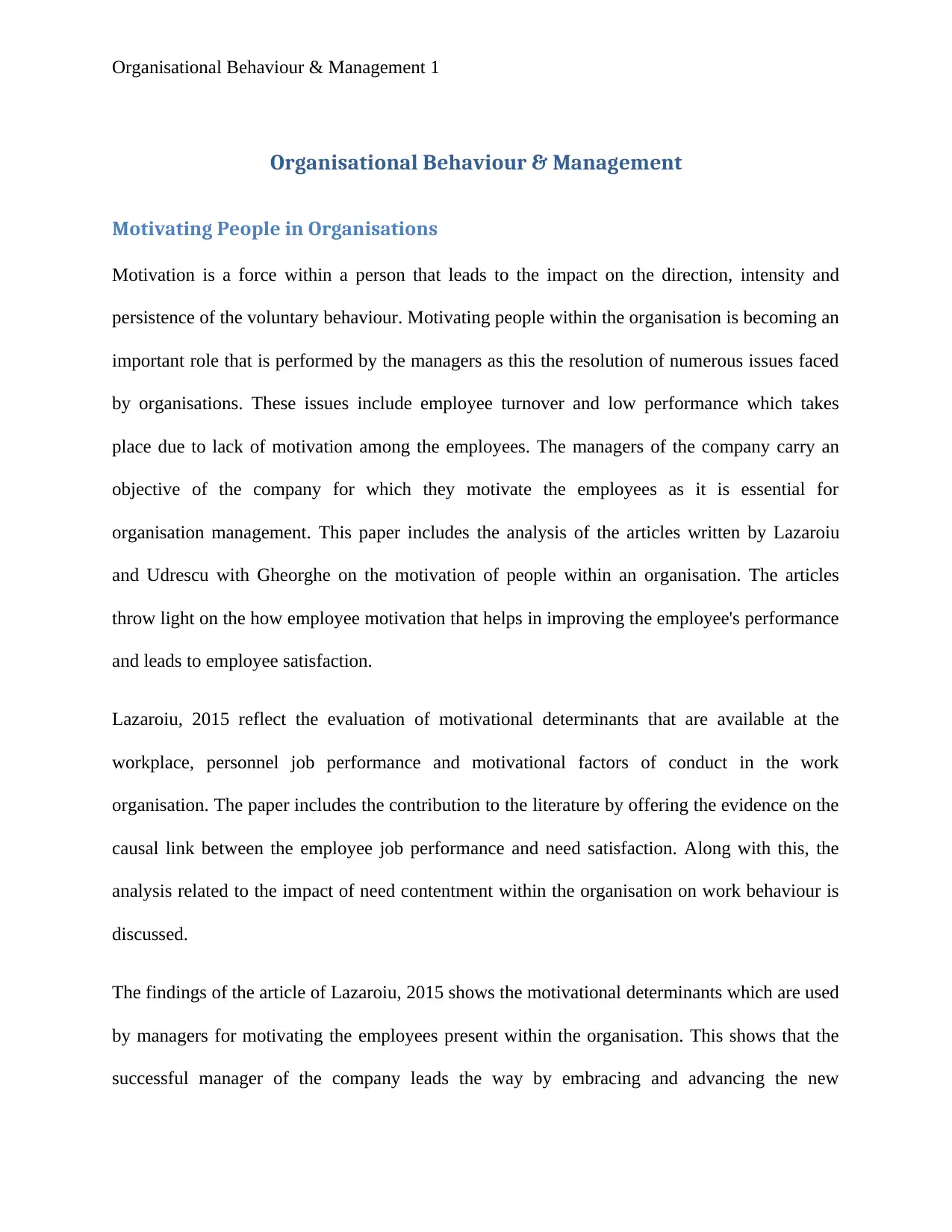
Organisational Behaviour & Management 1
Organisational Behaviour & Management
Motivating People in Organisations
Motivation is a force within a person that leads to the impact on the direction, intensity and
persistence of the voluntary behaviour. Motivating people within the organisation is becoming an
important role that is performed by the managers as this the resolution of numerous issues faced
by organisations. These issues include employee turnover and low performance which takes
place due to lack of motivation among the employees. The managers of the company carry an
objective of the company for which they motivate the employees as it is essential for
organisation management. This paper includes the analysis of the articles written by Lazaroiu
and Udrescu with Gheorghe on the motivation of people within an organisation. The articles
throw light on the how employee motivation that helps in improving the employee's performance
and leads to employee satisfaction.
Lazaroiu, 2015 reflect the evaluation of motivational determinants that are available at the
workplace, personnel job performance and motivational factors of conduct in the work
organisation. The paper includes the contribution to the literature by offering the evidence on the
causal link between the employee job performance and need satisfaction. Along with this, the
analysis related to the impact of need contentment within the organisation on work behaviour is
discussed.
The findings of the article of Lazaroiu, 2015 shows the motivational determinants which are used
by managers for motivating the employees present within the organisation. This shows that the
successful manager of the company leads the way by embracing and advancing the new
Organisational Behaviour & Management
Motivating People in Organisations
Motivation is a force within a person that leads to the impact on the direction, intensity and
persistence of the voluntary behaviour. Motivating people within the organisation is becoming an
important role that is performed by the managers as this the resolution of numerous issues faced
by organisations. These issues include employee turnover and low performance which takes
place due to lack of motivation among the employees. The managers of the company carry an
objective of the company for which they motivate the employees as it is essential for
organisation management. This paper includes the analysis of the articles written by Lazaroiu
and Udrescu with Gheorghe on the motivation of people within an organisation. The articles
throw light on the how employee motivation that helps in improving the employee's performance
and leads to employee satisfaction.
Lazaroiu, 2015 reflect the evaluation of motivational determinants that are available at the
workplace, personnel job performance and motivational factors of conduct in the work
organisation. The paper includes the contribution to the literature by offering the evidence on the
causal link between the employee job performance and need satisfaction. Along with this, the
analysis related to the impact of need contentment within the organisation on work behaviour is
discussed.
The findings of the article of Lazaroiu, 2015 shows the motivational determinants which are used
by managers for motivating the employees present within the organisation. This shows that the
successful manager of the company leads the way by embracing and advancing the new
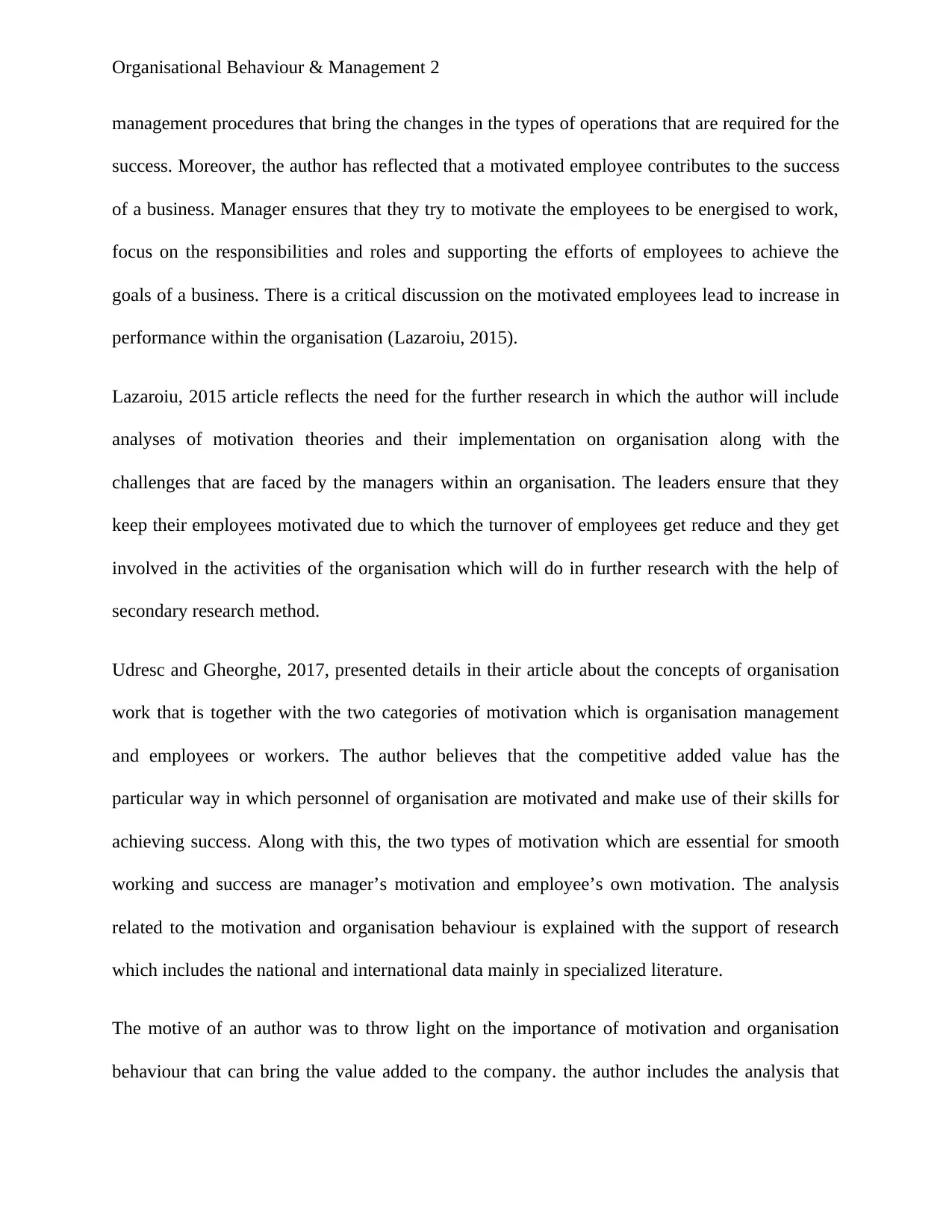
Organisational Behaviour & Management 2
management procedures that bring the changes in the types of operations that are required for the
success. Moreover, the author has reflected that a motivated employee contributes to the success
of a business. Manager ensures that they try to motivate the employees to be energised to work,
focus on the responsibilities and roles and supporting the efforts of employees to achieve the
goals of a business. There is a critical discussion on the motivated employees lead to increase in
performance within the organisation (Lazaroiu, 2015).
Lazaroiu, 2015 article reflects the need for the further research in which the author will include
analyses of motivation theories and their implementation on organisation along with the
challenges that are faced by the managers within an organisation. The leaders ensure that they
keep their employees motivated due to which the turnover of employees get reduce and they get
involved in the activities of the organisation which will do in further research with the help of
secondary research method.
Udresc and Gheorghe, 2017, presented details in their article about the concepts of organisation
work that is together with the two categories of motivation which is organisation management
and employees or workers. The author believes that the competitive added value has the
particular way in which personnel of organisation are motivated and make use of their skills for
achieving success. Along with this, the two types of motivation which are essential for smooth
working and success are manager’s motivation and employee’s own motivation. The analysis
related to the motivation and organisation behaviour is explained with the support of research
which includes the national and international data mainly in specialized literature.
The motive of an author was to throw light on the importance of motivation and organisation
behaviour that can bring the value added to the company. the author includes the analysis that
management procedures that bring the changes in the types of operations that are required for the
success. Moreover, the author has reflected that a motivated employee contributes to the success
of a business. Manager ensures that they try to motivate the employees to be energised to work,
focus on the responsibilities and roles and supporting the efforts of employees to achieve the
goals of a business. There is a critical discussion on the motivated employees lead to increase in
performance within the organisation (Lazaroiu, 2015).
Lazaroiu, 2015 article reflects the need for the further research in which the author will include
analyses of motivation theories and their implementation on organisation along with the
challenges that are faced by the managers within an organisation. The leaders ensure that they
keep their employees motivated due to which the turnover of employees get reduce and they get
involved in the activities of the organisation which will do in further research with the help of
secondary research method.
Udresc and Gheorghe, 2017, presented details in their article about the concepts of organisation
work that is together with the two categories of motivation which is organisation management
and employees or workers. The author believes that the competitive added value has the
particular way in which personnel of organisation are motivated and make use of their skills for
achieving success. Along with this, the two types of motivation which are essential for smooth
working and success are manager’s motivation and employee’s own motivation. The analysis
related to the motivation and organisation behaviour is explained with the support of research
which includes the national and international data mainly in specialized literature.
The motive of an author was to throw light on the importance of motivation and organisation
behaviour that can bring the value added to the company. the author includes the analysis that
⊘ This is a preview!⊘
Do you want full access?
Subscribe today to unlock all pages.

Trusted by 1+ million students worldwide
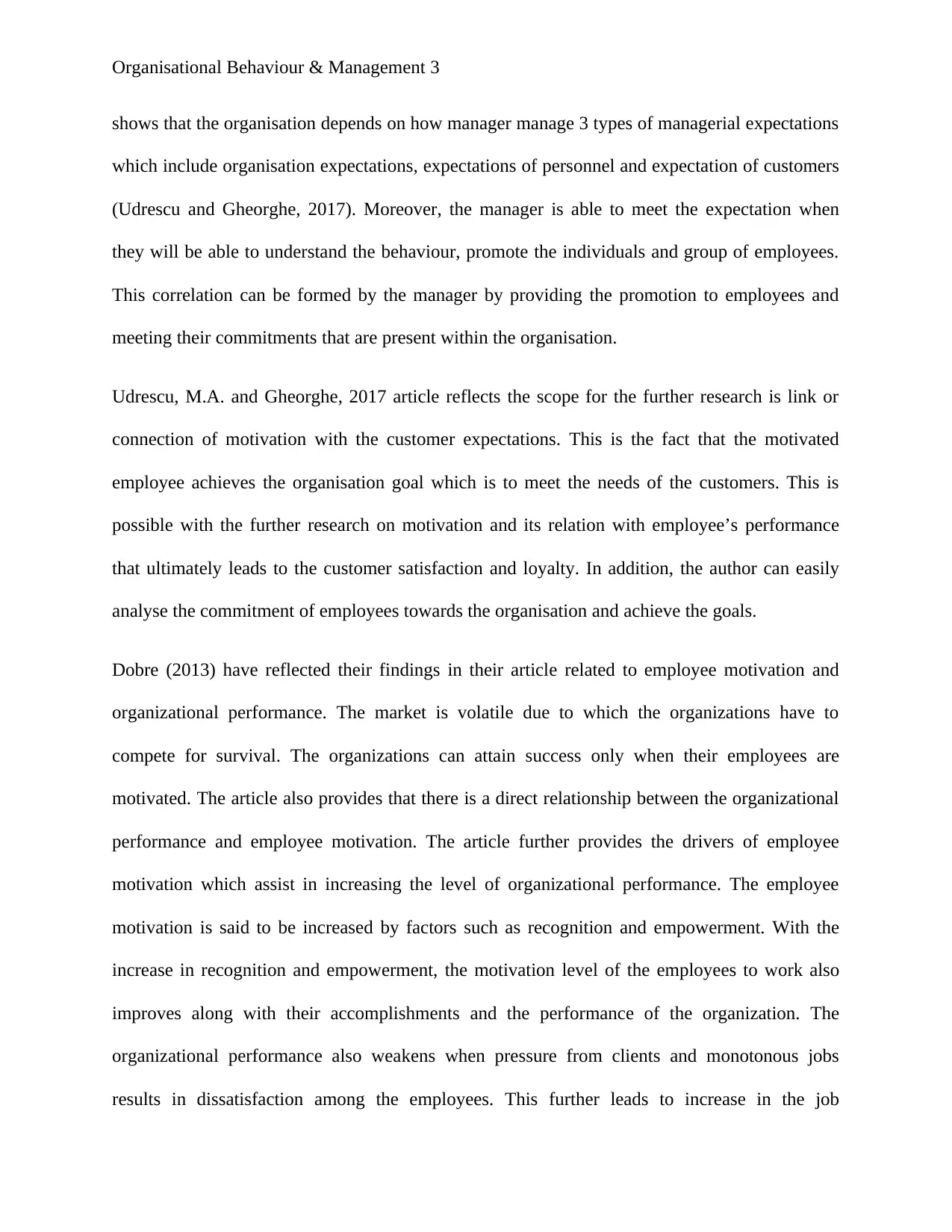
Organisational Behaviour & Management 3
shows that the organisation depends on how manager manage 3 types of managerial expectations
which include organisation expectations, expectations of personnel and expectation of customers
(Udrescu and Gheorghe, 2017). Moreover, the manager is able to meet the expectation when
they will be able to understand the behaviour, promote the individuals and group of employees.
This correlation can be formed by the manager by providing the promotion to employees and
meeting their commitments that are present within the organisation.
Udrescu, M.A. and Gheorghe, 2017 article reflects the scope for the further research is link or
connection of motivation with the customer expectations. This is the fact that the motivated
employee achieves the organisation goal which is to meet the needs of the customers. This is
possible with the further research on motivation and its relation with employee’s performance
that ultimately leads to the customer satisfaction and loyalty. In addition, the author can easily
analyse the commitment of employees towards the organisation and achieve the goals.
Dobre (2013) have reflected their findings in their article related to employee motivation and
organizational performance. The market is volatile due to which the organizations have to
compete for survival. The organizations can attain success only when their employees are
motivated. The article also provides that there is a direct relationship between the organizational
performance and employee motivation. The article further provides the drivers of employee
motivation which assist in increasing the level of organizational performance. The employee
motivation is said to be increased by factors such as recognition and empowerment. With the
increase in recognition and empowerment, the motivation level of the employees to work also
improves along with their accomplishments and the performance of the organization. The
organizational performance also weakens when pressure from clients and monotonous jobs
results in dissatisfaction among the employees. This further leads to increase in the job
shows that the organisation depends on how manager manage 3 types of managerial expectations
which include organisation expectations, expectations of personnel and expectation of customers
(Udrescu and Gheorghe, 2017). Moreover, the manager is able to meet the expectation when
they will be able to understand the behaviour, promote the individuals and group of employees.
This correlation can be formed by the manager by providing the promotion to employees and
meeting their commitments that are present within the organisation.
Udrescu, M.A. and Gheorghe, 2017 article reflects the scope for the further research is link or
connection of motivation with the customer expectations. This is the fact that the motivated
employee achieves the organisation goal which is to meet the needs of the customers. This is
possible with the further research on motivation and its relation with employee’s performance
that ultimately leads to the customer satisfaction and loyalty. In addition, the author can easily
analyse the commitment of employees towards the organisation and achieve the goals.
Dobre (2013) have reflected their findings in their article related to employee motivation and
organizational performance. The market is volatile due to which the organizations have to
compete for survival. The organizations can attain success only when their employees are
motivated. The article also provides that there is a direct relationship between the organizational
performance and employee motivation. The article further provides the drivers of employee
motivation which assist in increasing the level of organizational performance. The employee
motivation is said to be increased by factors such as recognition and empowerment. With the
increase in recognition and empowerment, the motivation level of the employees to work also
improves along with their accomplishments and the performance of the organization. The
organizational performance also weakens when pressure from clients and monotonous jobs
results in dissatisfaction among the employees. This further leads to increase in the job
Paraphrase This Document
Need a fresh take? Get an instant paraphrase of this document with our AI Paraphraser

Organisational Behaviour & Management 4
absenteeism rates and employee turnover of the organization. The employees might join the
competitors in which better work conditions and higher incentives are being offered. Also,
different strategies are required to be adopted for every individual because no two individuals are
same. For example, the motivation for one employee can be higher incentives, while some other
employee might get motivated by a better work environment or job satisfaction.
The employees are motivated towards higher performance through financial rewards as they can
use money for the purpose of satisfying their needs. The commitment and diligence of the
employees is significantly impacted by their pay. Therefore, pay acts as the key motivator for the
employees. However, pay is incapable of motivating an individual for a long term and does not
further result in the improvement of their performance. There are some non- financial factors
which also plays a great role in motivating the employees of the organization. Such non-
financial factors include social recognition, rewards and performance feedbacks. Moreover, there
is also an influence of empowerment on the performance of the organization. Responsibility and
authority is granted to people with the help of empowerment which, in turn, provides them with
the control of their own destinies. Productivity and profits of the organization also improve when
top- down decision making and autocratic leadership is followed in an organization. Such form
of decision making and leadership assists in creating a rigid work environment where orders are
given to the employees regarding the performance of the tasks. The article further provides that
the achievement of customer satisfaction becomes easier through empowerment as it facilitates
quick decision making by the employees without waiting for the instructions of the manager.
Manzoor (2011) reflect the factors affecting employee motivation and examines the relationship
between employee motivation and organizational effectiveness. This article has also identified
the same factors namely empowerment and recognition as the factors that positively affect the
absenteeism rates and employee turnover of the organization. The employees might join the
competitors in which better work conditions and higher incentives are being offered. Also,
different strategies are required to be adopted for every individual because no two individuals are
same. For example, the motivation for one employee can be higher incentives, while some other
employee might get motivated by a better work environment or job satisfaction.
The employees are motivated towards higher performance through financial rewards as they can
use money for the purpose of satisfying their needs. The commitment and diligence of the
employees is significantly impacted by their pay. Therefore, pay acts as the key motivator for the
employees. However, pay is incapable of motivating an individual for a long term and does not
further result in the improvement of their performance. There are some non- financial factors
which also plays a great role in motivating the employees of the organization. Such non-
financial factors include social recognition, rewards and performance feedbacks. Moreover, there
is also an influence of empowerment on the performance of the organization. Responsibility and
authority is granted to people with the help of empowerment which, in turn, provides them with
the control of their own destinies. Productivity and profits of the organization also improve when
top- down decision making and autocratic leadership is followed in an organization. Such form
of decision making and leadership assists in creating a rigid work environment where orders are
given to the employees regarding the performance of the tasks. The article further provides that
the achievement of customer satisfaction becomes easier through empowerment as it facilitates
quick decision making by the employees without waiting for the instructions of the manager.
Manzoor (2011) reflect the factors affecting employee motivation and examines the relationship
between employee motivation and organizational effectiveness. This article has also identified
the same factors namely empowerment and recognition as the factors that positively affect the
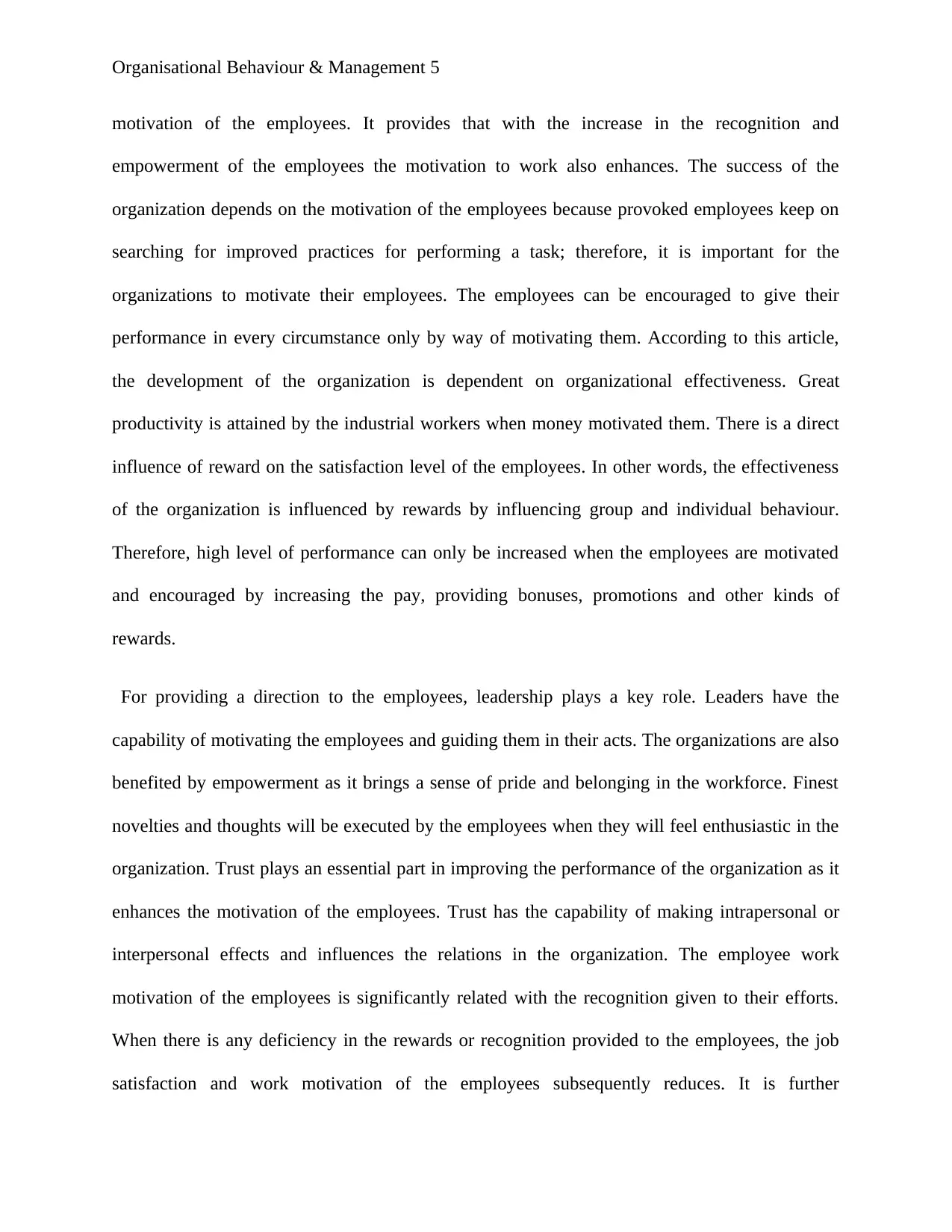
Organisational Behaviour & Management 5
motivation of the employees. It provides that with the increase in the recognition and
empowerment of the employees the motivation to work also enhances. The success of the
organization depends on the motivation of the employees because provoked employees keep on
searching for improved practices for performing a task; therefore, it is important for the
organizations to motivate their employees. The employees can be encouraged to give their
performance in every circumstance only by way of motivating them. According to this article,
the development of the organization is dependent on organizational effectiveness. Great
productivity is attained by the industrial workers when money motivated them. There is a direct
influence of reward on the satisfaction level of the employees. In other words, the effectiveness
of the organization is influenced by rewards by influencing group and individual behaviour.
Therefore, high level of performance can only be increased when the employees are motivated
and encouraged by increasing the pay, providing bonuses, promotions and other kinds of
rewards.
For providing a direction to the employees, leadership plays a key role. Leaders have the
capability of motivating the employees and guiding them in their acts. The organizations are also
benefited by empowerment as it brings a sense of pride and belonging in the workforce. Finest
novelties and thoughts will be executed by the employees when they will feel enthusiastic in the
organization. Trust plays an essential part in improving the performance of the organization as it
enhances the motivation of the employees. Trust has the capability of making intrapersonal or
interpersonal effects and influences the relations in the organization. The employee work
motivation of the employees is significantly related with the recognition given to their efforts.
When there is any deficiency in the rewards or recognition provided to the employees, the job
satisfaction and work motivation of the employees subsequently reduces. It is further
motivation of the employees. It provides that with the increase in the recognition and
empowerment of the employees the motivation to work also enhances. The success of the
organization depends on the motivation of the employees because provoked employees keep on
searching for improved practices for performing a task; therefore, it is important for the
organizations to motivate their employees. The employees can be encouraged to give their
performance in every circumstance only by way of motivating them. According to this article,
the development of the organization is dependent on organizational effectiveness. Great
productivity is attained by the industrial workers when money motivated them. There is a direct
influence of reward on the satisfaction level of the employees. In other words, the effectiveness
of the organization is influenced by rewards by influencing group and individual behaviour.
Therefore, high level of performance can only be increased when the employees are motivated
and encouraged by increasing the pay, providing bonuses, promotions and other kinds of
rewards.
For providing a direction to the employees, leadership plays a key role. Leaders have the
capability of motivating the employees and guiding them in their acts. The organizations are also
benefited by empowerment as it brings a sense of pride and belonging in the workforce. Finest
novelties and thoughts will be executed by the employees when they will feel enthusiastic in the
organization. Trust plays an essential part in improving the performance of the organization as it
enhances the motivation of the employees. Trust has the capability of making intrapersonal or
interpersonal effects and influences the relations in the organization. The employee work
motivation of the employees is significantly related with the recognition given to their efforts.
When there is any deficiency in the rewards or recognition provided to the employees, the job
satisfaction and work motivation of the employees subsequently reduces. It is further
⊘ This is a preview!⊘
Do you want full access?
Subscribe today to unlock all pages.

Trusted by 1+ million students worldwide
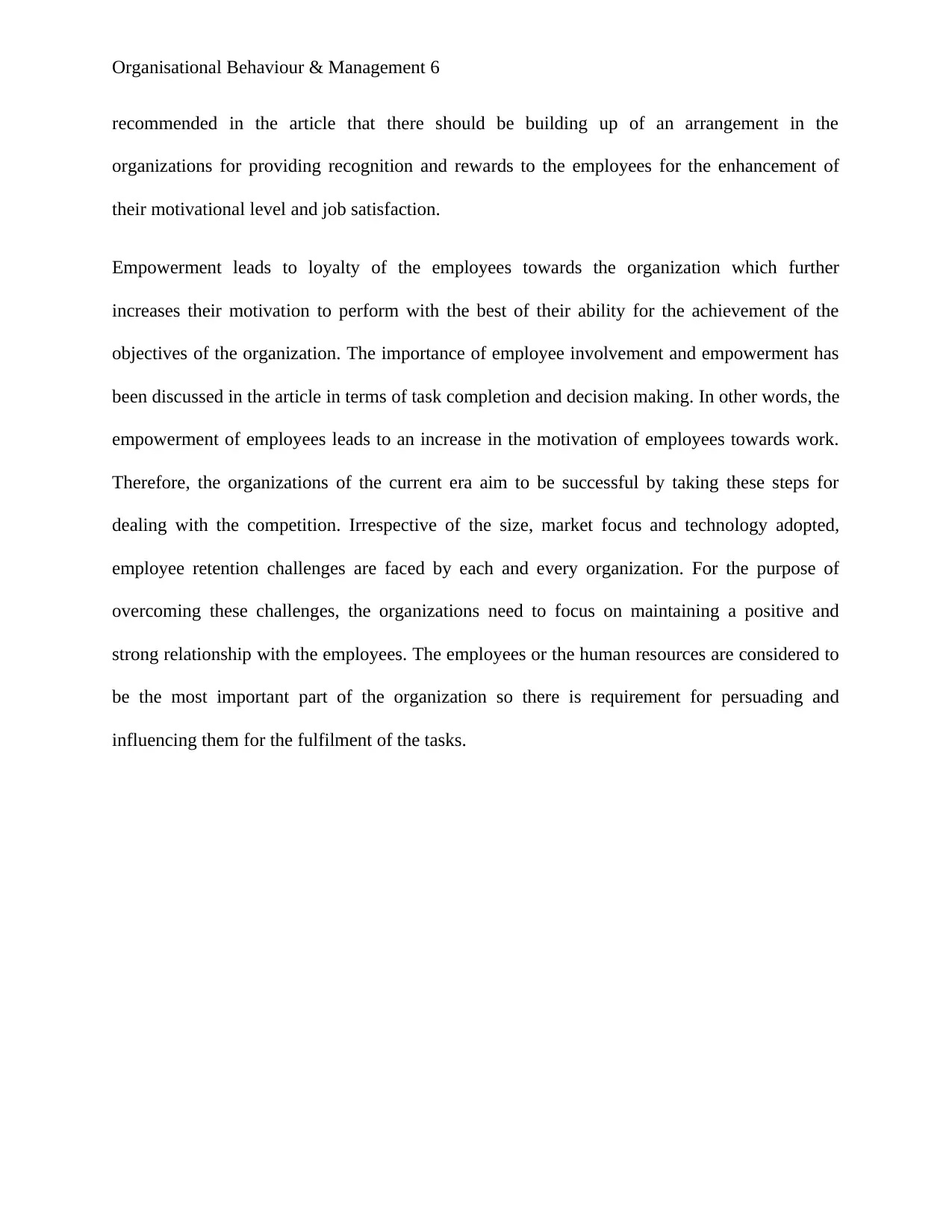
Organisational Behaviour & Management 6
recommended in the article that there should be building up of an arrangement in the
organizations for providing recognition and rewards to the employees for the enhancement of
their motivational level and job satisfaction.
Empowerment leads to loyalty of the employees towards the organization which further
increases their motivation to perform with the best of their ability for the achievement of the
objectives of the organization. The importance of employee involvement and empowerment has
been discussed in the article in terms of task completion and decision making. In other words, the
empowerment of employees leads to an increase in the motivation of employees towards work.
Therefore, the organizations of the current era aim to be successful by taking these steps for
dealing with the competition. Irrespective of the size, market focus and technology adopted,
employee retention challenges are faced by each and every organization. For the purpose of
overcoming these challenges, the organizations need to focus on maintaining a positive and
strong relationship with the employees. The employees or the human resources are considered to
be the most important part of the organization so there is requirement for persuading and
influencing them for the fulfilment of the tasks.
recommended in the article that there should be building up of an arrangement in the
organizations for providing recognition and rewards to the employees for the enhancement of
their motivational level and job satisfaction.
Empowerment leads to loyalty of the employees towards the organization which further
increases their motivation to perform with the best of their ability for the achievement of the
objectives of the organization. The importance of employee involvement and empowerment has
been discussed in the article in terms of task completion and decision making. In other words, the
empowerment of employees leads to an increase in the motivation of employees towards work.
Therefore, the organizations of the current era aim to be successful by taking these steps for
dealing with the competition. Irrespective of the size, market focus and technology adopted,
employee retention challenges are faced by each and every organization. For the purpose of
overcoming these challenges, the organizations need to focus on maintaining a positive and
strong relationship with the employees. The employees or the human resources are considered to
be the most important part of the organization so there is requirement for persuading and
influencing them for the fulfilment of the tasks.
Paraphrase This Document
Need a fresh take? Get an instant paraphrase of this document with our AI Paraphraser
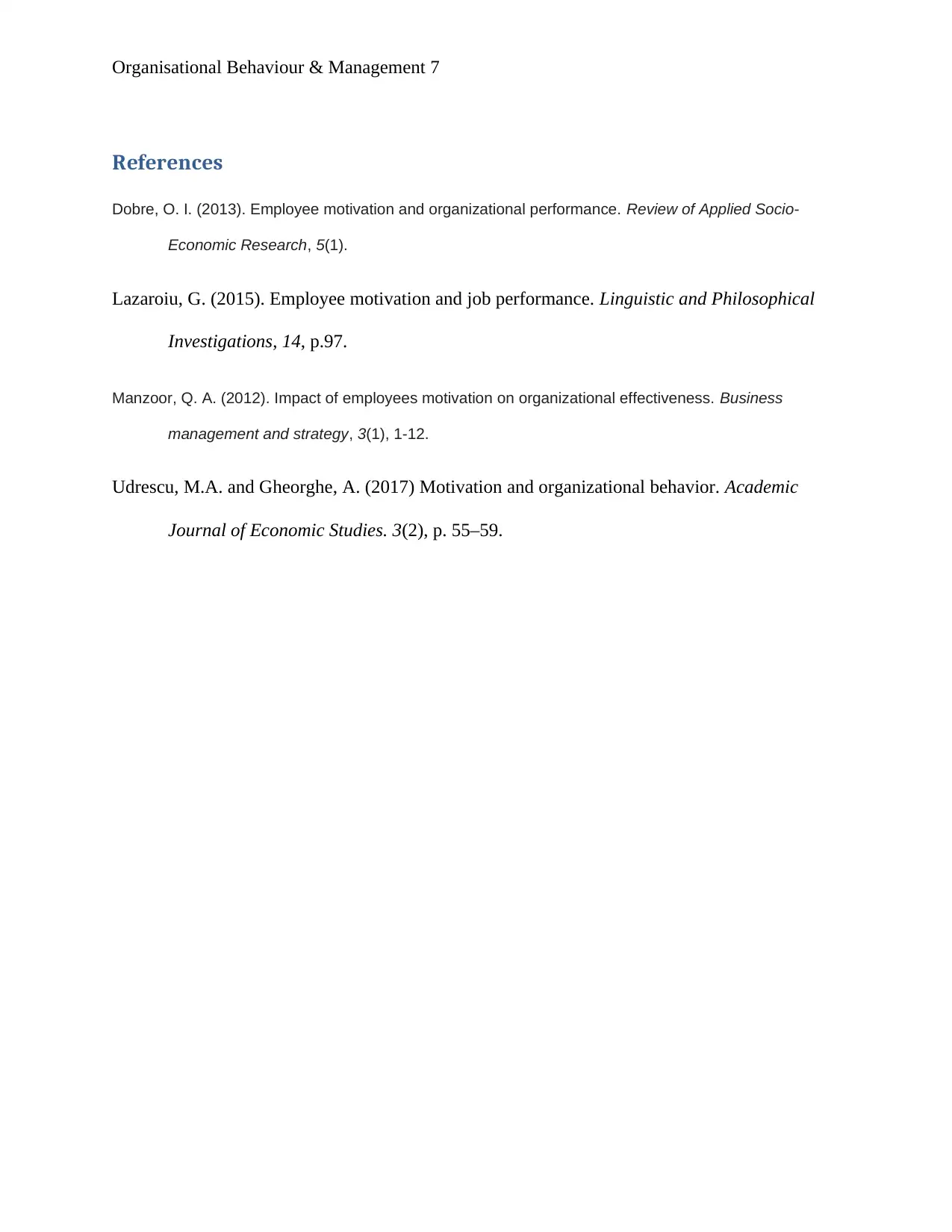
Organisational Behaviour & Management 7
References
Dobre, O. I. (2013). Employee motivation and organizational performance. Review of Applied Socio-
Economic Research, 5(1).
Lazaroiu, G. (2015). Employee motivation and job performance. Linguistic and Philosophical
Investigations, 14, p.97.
Manzoor, Q. A. (2012). Impact of employees motivation on organizational effectiveness. Business
management and strategy, 3(1), 1-12.
Udrescu, M.A. and Gheorghe, A. (2017) Motivation and organizational behavior. Academic
Journal of Economic Studies. 3(2), p. 55–59.
References
Dobre, O. I. (2013). Employee motivation and organizational performance. Review of Applied Socio-
Economic Research, 5(1).
Lazaroiu, G. (2015). Employee motivation and job performance. Linguistic and Philosophical
Investigations, 14, p.97.
Manzoor, Q. A. (2012). Impact of employees motivation on organizational effectiveness. Business
management and strategy, 3(1), 1-12.
Udrescu, M.A. and Gheorghe, A. (2017) Motivation and organizational behavior. Academic
Journal of Economic Studies. 3(2), p. 55–59.
1 out of 8
Related Documents
Your All-in-One AI-Powered Toolkit for Academic Success.
+13062052269
info@desklib.com
Available 24*7 on WhatsApp / Email
![[object Object]](/_next/static/media/star-bottom.7253800d.svg)
Unlock your academic potential
Copyright © 2020–2025 A2Z Services. All Rights Reserved. Developed and managed by ZUCOL.




